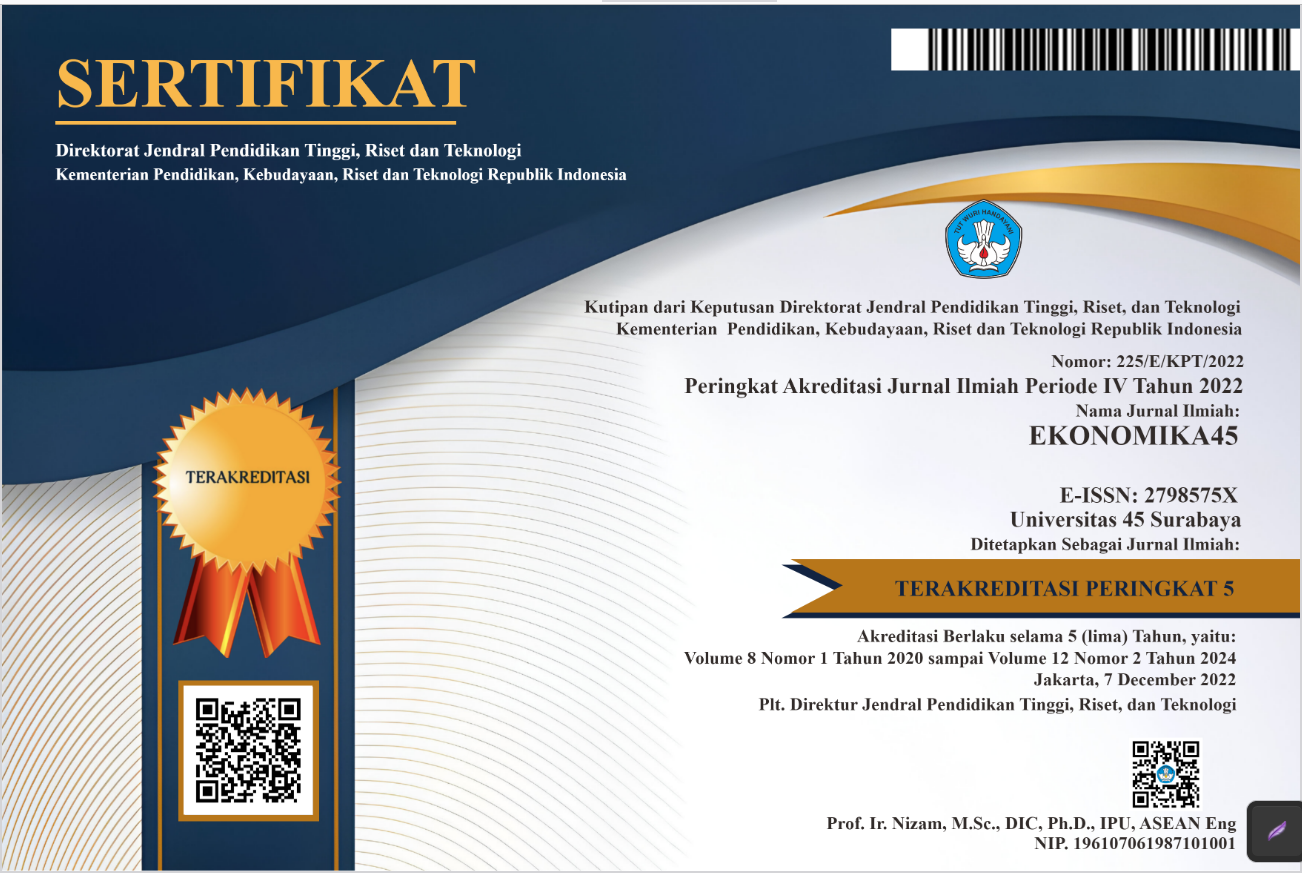The Response Of Income Inequality To Monetary Policy Shock In Indonesia: A Vecm Approach
DOI:
https://doi.org/10.30640/ekonomika45.v11i1.1867Keywords:
Gini Ratio, Inflation, Exchange Rate, Interest Rate, Money Supply, A VECM AproachAbstract
Income inequality has so far proven to be one of the global economic problems which has become a topic of economic problems in almost all countries in the world, especially developing countries including Indonesia. This study aims to examine the influence that exists on inflation, exchange rates, interest rates, and money supply on the gini ratio in Indonesia in the period 1993 to 2022. The type of data used in this study is quantitative data and the data sources used were obtained from the Agency Center for Statistics (BPS) in 1993-2022. This study uses the Vector Error Correction Model (VECM) research test to analyze the existence of a long-term and short-term relationship between the independent variable and the dependent variable in time series data. The final results of the study show that the data used in this study are stationary after the first differentiation. From the VECM estimation, only interest rates were proven to have a significant long-term relationship with other variables, while no short-term relationship was found between the variables studied. The Engle Granger Causality test also shows that there is no significant causal relationship between the Gini Ratio and Interest Rates, Money Supply, Exchange Rates, and Inflation.
References
Areosa, W. D., & Areosa, M. B. M. (2016). The inequality channel of monetary transmission. Journal of Macroeconomics, 48, 214–230. https://doi.org/10.1016/j.jmacro.2016.03.004
Bernanke, B. S. (2015). Monetary Policy and Inequality.
Casiraghi, M., Gaiotti, E., Rodano, L., & Secchi, A. (2018). A “reverse Robin Hood”? The distributional implications of non-standard monetary policy for Italian households. Journal of International Money and Finance, 85, 215–235. https://doi.org/10.1016/j.jimonfin.2017.11.006
Daimler. (2012). Daimler Annual Financial Report 2012. http://www.daimler.com/investor-relations/en
Daron, A. (2002). Technical change, inequality, and the labor market. Journal of Economic Literature, XL(March), 7–72.
Dwiputra, R. M. (2018). Analisis Faktor-Faktor Yang Mempengaruhi Ketimpangan Pendapatan Di Indonesia. Universitas Brawijaya.
Ghossoub, E. A., & Reed, R. R. (2017). Financial development, income inequality, and the redistributive effects of monetary policy. Journal of Development Economics, 126, 167–189. https://doi.org/10.1016/j.jdeveco.2016.12.012
Heryanah, H. (2017). Kesenjangan Pendapatan Di Indonesia: Berdasarkan Susenas 2008, 2011 Dan 2013. Jurnal BPPK : Badan Pendidikan Dan Pelatihan Keuangan, 10(2), 16. https://doi.org/10.48108/jurnalbppk.v10i2.26
Indra Putra, R. F., & Lisna, V. (2020). Segitiga Kemiskinan-Pertumbuhan-Ketimpangan (Pgi Triangle): Pembangunan Keuangan, Pembangunan Manusia, Dan Ketimpangan Pendapatan Di Asia. Jurnal Ekonomi Dan Pembangunan, 28(2), 77–89. https://doi.org/10.14203/jep.28.2.2020.77-89
Maesaroh, I., & Triani, L. F. (2011). Determinant of the Amount of Money Circulating in Indonesia. Fakultas Ekonomi Universitas Terbuka, 1–16.
Rahman, Y. P. (2011). Dampak Inflasi Terhadap Ketimpangan Pendapatan Dan Kemiskinan Di Indonesia 1976-2008. Journal Riset Daerah, X(3), 1636.
Surjaningsih, N., Utari, G. A. D., & Trisnanto, B. (2011). Bulletin of Monetary, Economics and Banking. Jurnal Bank Indonesia, 13(4), 353–470.
Todaro, M. P. dan S. C. S. (2006). Pembangunan Ekonomi (edisi kesembilan, jilid I). In Erlangga (p. edisi 9 Jilid 1).
Wibowo, T. (2017). Ketimpangan Pendapatan dan Middle Income Trap. Kajian Ekonomi Dan Keuangan, 20(2), 111–132. https://doi.org/10.31685/kek.v20i2.184
Daengs, G. S. A., Istanti, E., Negoro, R. M. B. K., & Sanusi, R. (2020). The Aftermath of Management Action on Competitive Advantage Through Proccess Attributes at Food and Beverage Industries Export Import in Perak Harbor of Surabaya. International Journal Of Criminology and Sociologi, 9, 1418–1425
Enny Istanti1), Bramastyo Kusumo2),I.N.(2020).IMPLEMENTASI HARGA,KUALITAS PELAYANAN DAN PEMBELIAN BERULANG PADA PENJUALAN PRODUK GAMIS AFIFATHIN. Ekonomika 45, 8(1), 1–10
Iwa Soemantri, Asep et al. 2020. Entrepreneurship Orientation Strategy, Market Orientation And Its Effect On Business Performance In MSMEs. Jurnal EKSPEKTRA Unitomo Vol. IV No. 1, Hal. 1-10
Downloads
Published
How to Cite
Issue
Section
License
Copyright (c) 2023 EKONOMIKA45 : Jurnal Ilmiah Manajemen, Ekonomi Bisnis, Kewirausahaan

This work is licensed under a Creative Commons Attribution-ShareAlike 4.0 International License.









